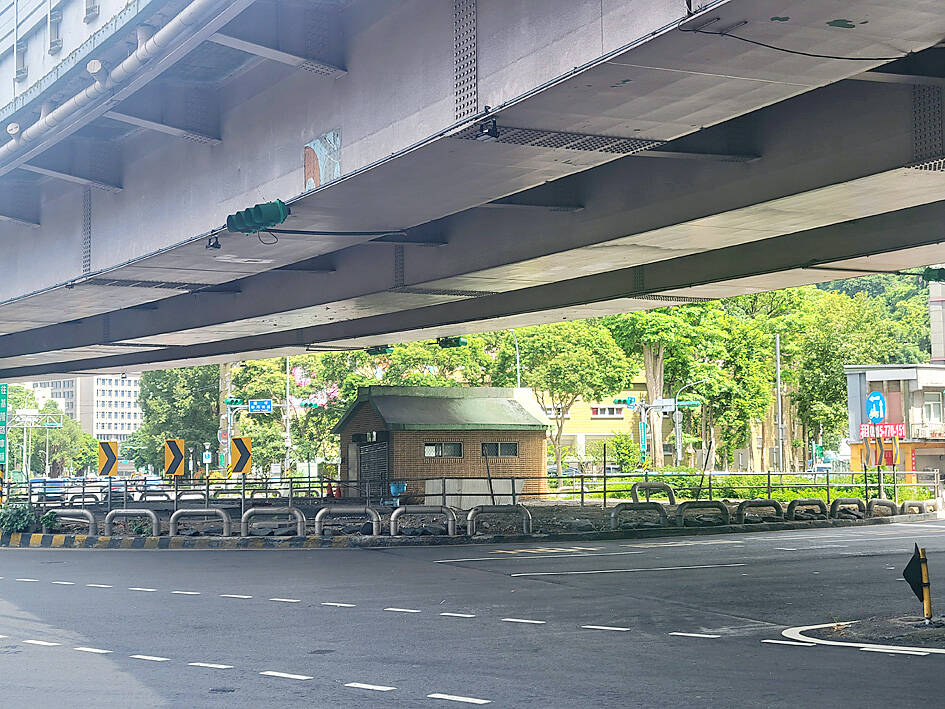The Taipei City Government yesterday said it would begin removing the Gongguan roundabout and filling in the bus underpass on Saturday as scheduled, despite protests by civic groups and city councilors.
The project is expected to be completed in late November, replacing the roundabout at Roosevelt Road and Keelung Road and its three lanes with a standard four-way junction controlled by traffic lights, the Taipei Department of Transportation said.
However, civic groups and road safety activists, who plan to stage protests on Friday, have argued that the roundabout should remain and instead be upgraded with clearer markings and signage.

Photo: Ho Yu-hua, Taipei Times
Taipei City Councilor Miao Po-ya (苗博雅) has also questioned the city’s evaluation methods, saying that closing the underpass would worsen traffic congestion in the area.
Department Commissioner Hsieh Ming-hong (謝銘鴻) said that safety is a priority.
The redesign is based on more than two decades of studies and has been endorsed by academics and road safety experts as the best solution, Hsieh said.
The roundabout, built in 1967, has been the top site for traffic accidents in the city for the past seven consecutive years, Hsieh said.
He said that filling in the underpass is necessary to resolve structural load issues, and while traffic would be congested for about two months, alternative routes and real-time traffic monitoring would be established.
The plan is to start with sealing and filling in the underpass over a 44-day period, followed by the demolition of the roundabout in 21 days, he said.
According to the department, the redesign would shorten the pedestrian crossings by 23 percent, expand walking space and give buses more space at the intersection.
While some people have expressed concern that merging the bus lanes with regular traffic could worsen congestion, simulations indicate that about 60 percent of buses would be able to navigate the intersection when they have the green light, the department said.

Trips for more than 100,000 international and domestic air travelers could be disrupted as China launches a military exercise around Taiwan today, Taiwan’s Civil Aviation Administration (CAA) said yesterday. The exercise could affect nearly 900 flights scheduled to enter the Taipei Flight Information Region (FIR) during the exercise window, it added. A notice issued by the Chinese Civil Aviation Administration showed there would be seven temporary zones around the Taiwan Strait which would be used for live-fire exercises, lasting from 8am to 6pm today. All aircraft are prohibited from entering during exercise, it says. Taipei FIR has 14 international air routes and

Taiwan lacks effective and cost-efficient armaments to intercept rockets, making the planned “T-Dome” interception system necessary, two experts said on Tuesday. The concerns were raised after China’s military fired two waves of rockets during live-fire drills around Taiwan on Tuesday, part of two-day exercises code-named “Justice Mission 2025.” The first wave involved 17 rockets launched at 9am from Pingtan in China’s Fujian Province, according to Lieutenant General Hsieh Jih-sheng (謝日升) of the Office of the Deputy Chief of the General Staff for Intelligence at the Ministry of National Defense. Those rockets landed 70 nautical miles (129.6km) northeast of Keelung without flying over Taiwan,

The Ministry of National Defense (MND) today released images of the military tracking China’s People's Liberation Army (PLA) movements during the latest round of Chinese drills around Taiwan. The PLA began "Justice Mission 2025" drills today, carrying out live-fire drills, simulated strikes on land and maritime targets, and exercises to blockade the nation's main ports. The exercises are to continue tomorrow, with the PLA announcing sea and air space restrictions for five zones around Taiwan for 10 hours starting from 8:30am. The ministry today released images showing a Chinese J-16 fighter jet tracked by a F-16V Block 20 jet and the

City buses in Taipei and New Taipei City, as well as the Taipei MRT, would on Saturday begin accepting QR code payments from five electronic payment providers, the Taipei Department of Transportation said yesterday. The new option would allow passengers to use the “transportation QR code” feature from EasyWallet, iPass Money, iCash Pay, Jkopay or PXPay Plus. Passengers should open their preferred electronic payment app, select the “transportation code” — not the regular payment code — unlock it, and scan the code at ticket readers or gates, General Planning Division Director-General Liu Kuo-chu (劉國著) said. People should move through the